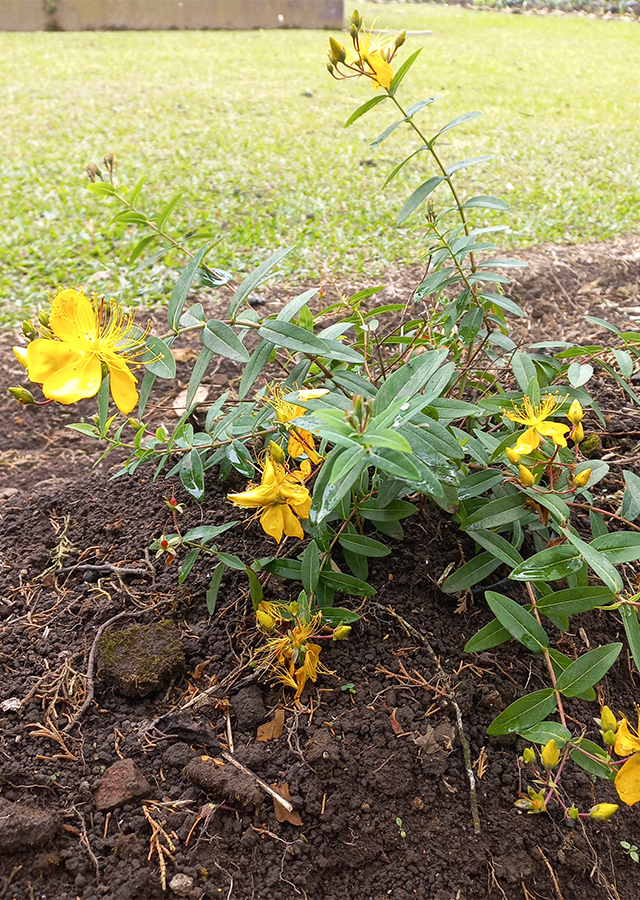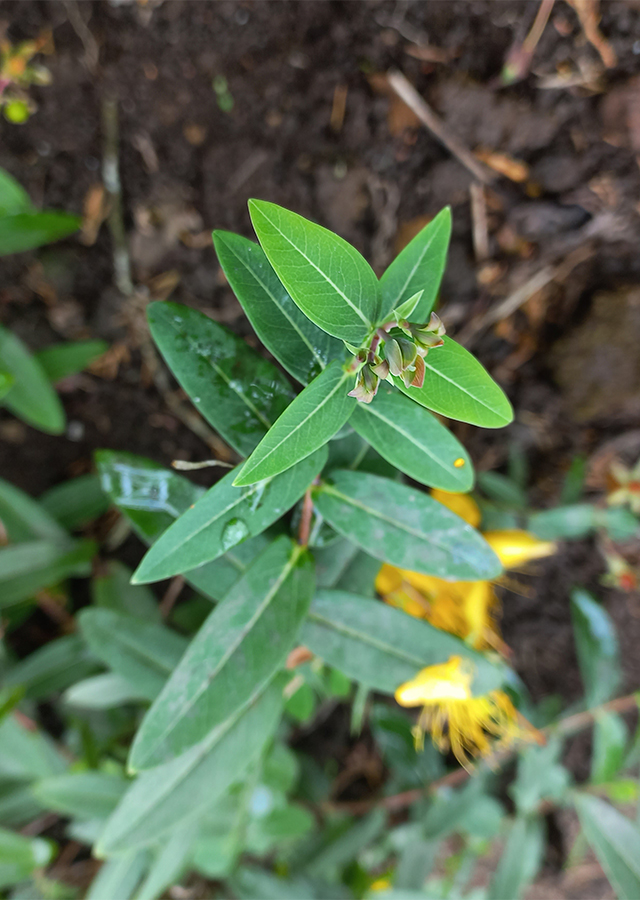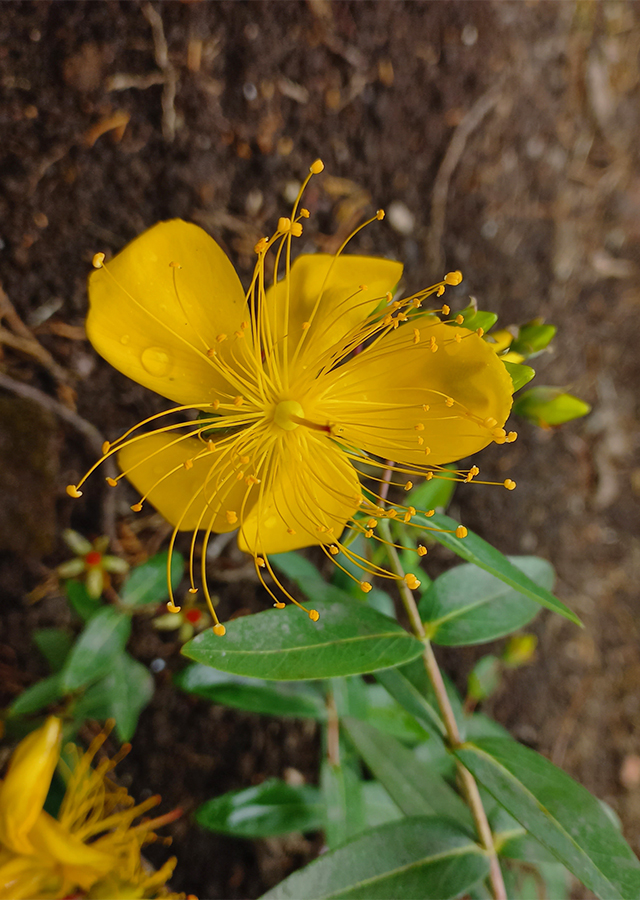St. John's Wort
Hypericum perforatum L.
Hypericaceae
Location in our garden
Principal



Synonym
Hypericum officinale Gaterau
Hypericum officinarum Crantz
Hypericum vulgare Lam.
Habitus
Herbaceous. A perennial plant that can grow up to 0.90 m tall
Part Used
Leaves
Flowers
The Whole Plant
Growing Requirements
Full Sunshine
Need Shade
Habitat
Forest
Grassland
Terrestrial
Overview
St. John's Wort originates from Europe, including England, south and east spreading to North Africa, the Azores, Madeira and West Asia. St. John's wort has a long history of herbal use. This plant fell out of favor in the nineteenth century but recent research has brought it back to prominence as an invaluable remedy for nervous problems. In clinical trials about 67% of patients with mild to moderate depression improved when taking this plant. St. John's wort (Hypericum perforatum L. 1753, Hypericaceae), a species widely used in traditional and conventional medicine.
Vernacular Names
No found data on this. Need further research.
Agroecology
Found growing on open woods, hedgebanks and grassland, in dry sunny places. Easily grown in any reasonably good well-drained but moisture retentive soil. Plants grow well in sun or semi-shade but they flower better when in a sunny position.
Morphology
- Stems - reddish, erect and branching above, can grow to a height of 1 m (3 ft 3 in). The stems are woody near the base and may appear fused from leaf scars. The branches are usually clustered around a depressed base.
- Leaves - opposite, stemless, narrow and oval in shape, 1-2 cm (0.39-0.79 in) long. Leaves borne on branches cover shortened branches. The leaves are yellow-green in color, with scattered dots of glandular tissue. The dots stand out when exposed to light, giving the leaves a "hollowed" appearance in reference to the plant's Latin name.
- Flowers - measuring up to 2.5 cm (0.98 in), has five petals and sepals, bright yellow with prominent black dots. The flowers appear in broad helicoid cymes at the tips of the upper branches, between late spring and early to midsummer. Cymes are leafy and produce many flowers. The pointed sepals have a black gland point. The numerous stamens unite at the base into three bundles. The pollen grains are ellipsoidal in shape.
- Seeds - black and shiny, rough, netted with rough grooves.
Cultivation
- Propagated by seeds - sow in a greenhouse as soon as it is ripe in the autumn or in the spring. It normally germinates in 1 - 3 months at 10 °C. Prick out the seedlings into individual pots when they are large enough to handle and plant them out into their permanent positions in the summer.
- By division - very easy, larger clumps can be replanted direct into their permanent positions, though it is best to pot up smaller clumps and grow them on in a cold frame until they are rooting well. Plant them out in the spring.
Chemical Constituents
Phloroglucinols (hyperforin, adhyperforin), naphtodianthrones (hypericin, pseudohypericin), flavonoids (rutin, quercetin, quercitrin, isoquercitrin, hyperoside, and amentoflavone), phenolic acids, pectin, choline sitosterol, and small amounts of essential oils.
Traditional Medicinal Uses
- The flowers and leaves are analgesic, antiseptic, antispasmodic, aromatic, astringent, cholagogue, digestive, diuretic, expectorant, nervine, resolvent, sedative, stimulant, vermifuge and vulnerary.
- The herb is used in treating a wide range of disorders, including pulmonary complaints, bladder problems, diarrhoea and nervous depression.
- Externally, it is used in poultices to dispel herd tumours, caked breasts, bruising etc.
- The plant was used to procure an abortion by some native North Americans, so it is best not used by pregnant women.
- A tea or tincture of the fresh flowers is a popular treatment for external ulcers, burns, wounds (especially those with severed nerve tissue), sores, bruises, cramps etc.
- An infusion of the flowers in olive oil is applied externally to wounds, sores, ulcers, swellings, rheumatism etc. It is also valued in the treatment of sunburn and as a cosmetic preparation to the skin.
- A homeopathic remedy is made from the fresh whole flowering plant. It is used in the treatment of injuries, bites, stings etc and is said to be the first remedy to consider when nerve-rich areas such as the spine, eyes, fingers etc are injured.
Part Used
Reference Sources
- Royal Botanic Gardens. Plants of the World Online: Hypericum perforatum L. https://powo.science.kew.org/taxon/urn:lsid:ipni.org:names:433719-1. 02-06-22.
- Useful Temperate Plants. 2022. Hypericum perforatum. http://temperate.theferns.info/plant/Hypericum+perforatum. 02-06-22.
- Nebojša Kladar, Jasminka Mrđanović, Goran Anačkov, Slavica Šolajić, Neda Gavarić, Branislava Srđenović, dan Biljana Božin. 2017. Hypericum perforatum: Synthesis of Active Principles during Flowering and Fruitification—Novel Aspects of Biological Potential. Journal hindawi. Volume 2017 |Article ID 2865610 | https://doi.org/10.1155/2017/2865610. https://www.hindawi.com/journals/ecam/2017/2865610/.
- Portillo Jerman. Hypericum perforatum (Hyperic). https://www.jardineriaon.com/id/hypericum-perforatum.html.


